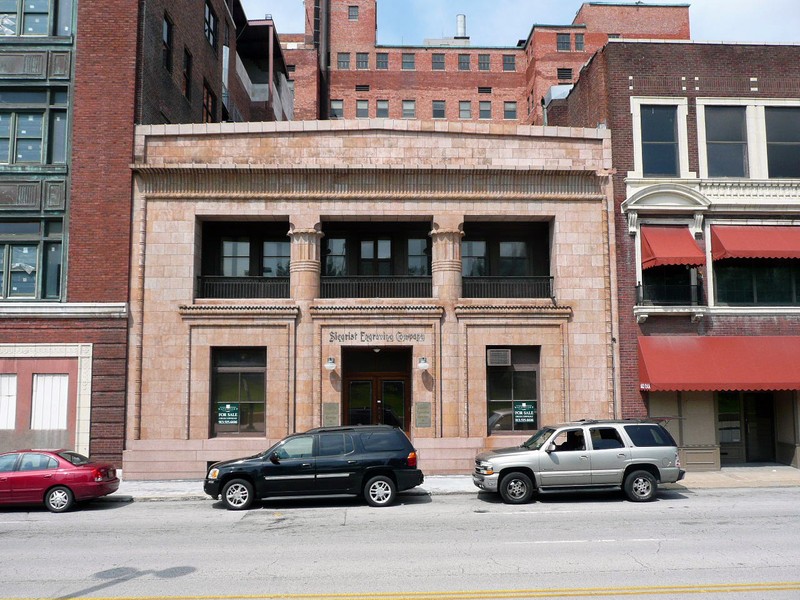Stine & McClure Undertaking Company Building
Introduction
Text-to-speech Audio
This historic downtown building demonstrates the cultural fascination with ancient Egypt, referred to as Egyptomania, that swept the United States during the nineteenth and early twentieth centuries. Completed in 1912 for the Stine & McClure Undertaking Company, this is the only Neo-Egyptian Revival style commercial building that survives to the present and serves as reminder of the impactful work of John McKecknie, a prolific Kansas City architect. The exterior design takes its inspiration from ancient Egyptian tombs, a fitting choice for a funeral business.
Images
Stine and McClure Undertaking Company Building

Backstory and Context
Text-to-speech Audio
The Stine family began their undertaking business in Kansas City during the infancy of the Civil War, long before the city grew into a major metropolis. Edward Stine arrived in Kansas City in 1860 with his wife and promptly took a job with the undertaking firm of Henning & McLaughlin. One year later, in 1861, Stine took over the business after the partners retired. In addition to the Civil War, two cholera epidemics kept Stine busy. W.F Stine, Edward's son, joined the business in 1886, followed by apprentice-turned-partner William M. McClure in 1906; the company changed its name to Stine & McClure Undertaking Co.
The company experienced continued growth into the early 1910s. For instance, Stine & McClure became the first city's first funeral business to use a motorized hearse (although some viewed that as distasteful). Also, in 1912, Stine & McClure hired the lauded John McKecknie to build the now-historic structure. McKecknie, a Princeton graduate (1886), worked first for the Brooklyn Institute of Arts and Sciences as an architecture professor and then for the Metropolitan Museum of Art where he had his first professional encounter with antiquity and other historical eras; he managed the installation of full-sized sections of the Parthenon, the Temple of Vespasian, and models of the Cathedral of Notre Dame. He moved to Kansas City in 1898 just as the city experienced a commercial and residential construction boom, coinciding with a 54% population increase between 1900 and 1910.
McKecknie designed for Stine & McClure a building that ostensibly serves as Kansas City's only example of the Neo-Egyptian style of architecture on a commercial building. Napoleon's Egyptian campaign during the early nineteenth century sparked a scientific and cultural fascination with ancient Europe that impacted the Western World through the early twentieth century. Scientists and academic scholars accompanied Napoleon on his journey through Egypt, leading to a barrage of expeditions to the once-powerful ancient empire to document its relics, engage in archaeological digs, explore the tombs, and interpret the ancient hieroglyphs. The abundance of discoveries intrigued scholars and captivated a large portion of the Western populace, as seen by its influence on literature, artwork, film, and architecture. The Stine & McClure building's granite front, columns, and decor— alluding to an Egyptian tomb — reflect the imaginative architectural interpretations of ancient Egyptian culture. Because the building is sandwiched between two larger commercial buildings, only its front exterior is decorated, but the building's interior exudes Egyptian influences, as well.
Because the small storefront arose in the midst of a Kansas City building boom, it drew little attention at the time. Most viewed the design as conservative rather than innovative. Still, it survives today as a reminder of the wave of Egyptomania that swept through Europe and North America at the time, and it stands as one of nearly 120 commercial and residential structures completed by McKecknie during his career, many of which involved an adaption of historical styles to modern construction methods.
Sources
Curl, James Stevens. The Egyptian Revival: Ancient Egypt as an Inspiration for Design Motifs in the West. London: Routledge, 2005.
Elliott, Bridget. “Art Deco Worlds in a Tomb: Reanimating Egypt in Modern(Ist) Visual Culture.” South Central Review 25, no. 1 (2008): 114–35. http://www.jstor.org/stable/40040022.
Ford, Susan Jezak. "Stine & McClure Undertaking." Missouri Valley Special Collections, Kansas City Public Library, Kansas City, Missouri. kchistory.org. 2003. https://kchistory.org/document/stine-and-mcclure-undertaking-company-building-profile.
Ickow, Sara. “Egyptian Revival.” In Heilbrunn Timeline of Art History. New York: The Metropolitan Museum of Art. July 2012. http://www.metmuseum.org/toah/hd/erev/hd_erev.htm.
Lazarski, Andrea. "Stine and McClure Undertaking Company Building." National Register of Historic Places. mostateparks.com. 1988. https://mostateparks.com/sites/mostateparks/files/Stine%20and%20McClure%20Undertaking%20Co.%20Bldg.pdf.
By Mwkruse - Own work, CC BY-SA 3.0, https://commons.wikimedia.org/w/index.php?curid=42409546
